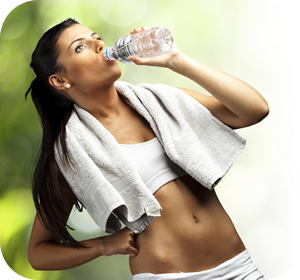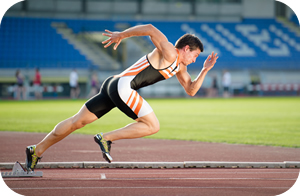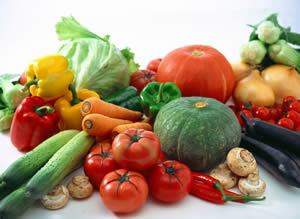Dr. Abelson’s Essential Nutritional Program – Part 3
 Water Keeps You Healthy
Water Keeps You Healthy
We can continue living without food for several months, but we can only stay alive for a few days without water. Water is second only to oxygen in importance to your body. Our bodies are approximately 70% water. Water is essential for:
- Transportation of oxygen and nutrients into our cells.
- Removal of waste from our bodies.
- Temperature regulation.
- Metabolism.
- Protein synthesis.
- Brain function.
- Kidney function.
- Nutrient transportation and absorption.
- Overall digestive function.
- Normal joint function.
- Moisturizing our lungs.
How much water should I drink?
Answering this question is not as easy as you may think . When it comes to water consumption dietary experts can have very different ideas on how much water we should consume. What they do agree about are the universal benefits of staying hydrated. What they will also agree about are the signs of dehydration:
Mild dehydration (2% fluid loss)
Mild dehydration is characterized by:
- Thirst, dark urine, fatigue, chills, dry skin, head rushes, loss of appetite
Increased level of dehydration (5% fluid loss)
Increased dehydration is characterized by:
- Increased heart rate and respiration.
- Decreased urine output and sweating.
- Increased body temperature.
- Muscle cramping.
- Nausea.
- Headaches.
- Extreme fatigue.
- Tingling in your extremities.
Extreme dehydration (10% loss of fluid)
Extreme dehydration is characterized by:
- Severe muscle spasms.
- Increased heart rate.
- Confusion, vomiting.
- Seizures.
- Severe chest and abdominal pain.
- Difficulty breathing.
- Unconsciousness and even death.
My Personal Opinion
 Based on personal experience (both as a marathon runner and my clinical experience), I recommend the following guidelines for avoiding dehydration:
Based on personal experience (both as a marathon runner and my clinical experience), I recommend the following guidelines for avoiding dehydration:
Inactive individuals should drink approximately 1/2 ounce of water per pound of body weight. That works out to eight, ten-ounce glasses of water if you weigh 160 pounds. The Institute of Medicine recommends 3 litres of fluid for men and 2.2 litres for women.
If you are very active (for example: a runner or someone doing higher levels of aerobic activity) you will need approximately 2/3 ounce of water per pound of body weight (that would be about 12 glasses a day for a 160 pound individual). For example, on a recent trip to Cambodia, I probably drank twice that amount on a daily basis due to the extremely high temperatures we encountered while we were hiking through the countryside.
I know this sounds like a lot of water, but it really is not. Yes, for the first few weeks you will be going to the bathroom frequently. After about two weeks your body will adjust, then your restroom visits will decrease substantially.
What most people will notice, besides the initial frequent bathroom breaks, are some substantial positive changes in the way they feel: better digestion, better bowel movements, easier breathing, and decreased joint pain are often some of the first positive signs.
Your Urine
 Alright, lets discuss everyone’s favorite topic “Your Urine”…yeah….definitely kidding! Doing a quick check of your urine can actually give you a lot of information. For example, your urine should be a clear to pale-yellow colour. It should NOT be dark yellow, brownish, and definitely not red ( unless you have been eating red beets). It should also not be cloudy, or have a really strong smell to it.
Alright, lets discuss everyone’s favorite topic “Your Urine”…yeah….definitely kidding! Doing a quick check of your urine can actually give you a lot of information. For example, your urine should be a clear to pale-yellow colour. It should NOT be dark yellow, brownish, and definitely not red ( unless you have been eating red beets). It should also not be cloudy, or have a really strong smell to it.
So, lets do a quick review of what you can learn by observing your urine. Keep in mind, short term changes in colour are usually nothing to be overly concerned about.
When your urine is completely clear, no colour at all:
- You could be over-hydrated; you are consuming too much fluid. Your body is trying to get rid of excess water that you don’t need.
- If your skin is also bright yellow/jaundiced, I recommend getting checked out to make sure you don’t have hepatitis. (This a rare occurrence.)
When your urine is dark yellow:
- This dark yellow colour indicates dehydration. No matter how much water you think you should drink, you are still not drinking enough to properly hydrate yourself.
When your urine is orange
- This could be dehydration.
- It can also be related to the foods that you consume: beets, berries, or foods containing artificial colours.
When your urine is bright yellow:
- This is usually an indication that you are not absorbing your vitamins and supplements very well or that you are taking too many supplements. Note: this usually does not happen when you take food-based natural supplements.
When your urine is blue or green:
- This can be the related to foods that contain high levels of artificial colourings.
- This can be the side-effect of certain medications.
- If this persists, see your doctor.
When your urine is dark brown
- This could be just dehydration, but if you also have really pale stools, you could be dealing with a liver disorder such as hepatitis.
When your urine is red
- This could be the foods you have eaten: beets, berries or foods with red dye.
- On a more serious note, this could be an indication of a kidney or bladder infection.
When your urine is not clear but cloudy or murky
- This may be an indication of a urinary tract infection. If this cloudy urine occurs in combination with a fever, urinary urgency, and abdominal pain, then you need to see your physician.
When your urine smells bad
- Beside being just gross, this could be an indication of dehydration which gives urine a strong ammonia smell.
- Foul smelling urine combined with: increase frequency, back pain, fever, or odd colour, could be an indication of a bacterial infection.
- Sweet smelling urine could be an indication of a metabolic disease.
Electrolyte replacement drinks
 Electrolyte replacement drinks have become an integral component in the training programs of many endurance athletes. Without these drinks many athletes claim that their performance and recovery is greatly diminished.
Electrolyte replacement drinks have become an integral component in the training programs of many endurance athletes. Without these drinks many athletes claim that their performance and recovery is greatly diminished.
This is especially the opinion of athletes that train for extended period of time such as triathletes and marathon runners. This is due to the fact that when you exercise at high levels – for an hour or more – you start to diminish your body’s electrolyte stores.
The electrolytes in your body conduct electrical charges – they have either a positive or negative charge to them. These electrolytes are essential for overall neurological function, muscle contraction, and maintaining fluid balance.
Although you lose a variety of electrolytes during exercise, the electrolytes lost in the highest concentration are sodium and chloride. Personally, I usually feel better when I use these drinks during long workouts. I am certainly not a high-end athlete, so I am not sure how much it affects my performance, but I do notice a difference on my overall level of fatigue, and that I have reduced recovery times when I use these drinks.
Diet and Electrolytes
While we are on the topic of electrolytes, don’t forget that your food is the best resource for replacing the electrolytes that you lost through exercise. The following list shows the most common electrolytes lost through exercise, the symptoms that occur when you are deficient in these electrolytes, and some of the foods that you can use to replace them.
Sodium
(Just remember, too much salt is definitely NOT healthy.)
- Signs of Deficiency: Muscle cramps, dizziness, and loss of appetite.
- Food Sources: Table salt, tomato juice, tomato sauce, soy sauce, salad dressings, sun-dried tomatoes, cheese, and pickled foods.
- Signs of Deficiency: Irregular heart beat, loss of appetite, muscle weakness, lethargy, and dehydration which can eventually lead to alkalosis.
- Food Sources: Tomatoes, lettuce, celery, olives, seaweed, and rye.
Potassium
- Signs of Deficiency: muscle weakness, spasms, cramps, mental confusion, abdominal bloating/pain/cramping, heart palpitations, frequent urination, and extreme thirst.
- Food Sources: Dark leafy greens, bananas, white beans, baked potatoes, dried apricots, plain yogurt, salmon, avocados, and white mushrooms.
Magnesium
- Signs of Deficiency: Low energy, fatigue, weakness, muscle, cramps, nausea, confusion, PMS and hormonal imbalances, insomnia, abnormal heart rhythm, headaches, anxiety, and kidney stones.
- Food Sources: Spinach, pumpkin seeds, swiss chard, sesame seeds, soya beans, halibut, black beans, sunflower seeds, cashews, and almonds.
Calcium
- Signs of Deficiency: Numbness and tingling in the fingers, lethargy, muscle cramps, poor appetite, mental confusion, dermatitis, osteoporosis, and rickets.
- Food Sources: Cabbage, broccoli, kale, bok choy, turnip greens, tofu, organic dairy products, and canned fish (the bones).
More Information
For the rest of Dr. Abelson’s Essential Nutritional Program, read the following blogs:
- Dr. Abelson’s Essential Nutritional Program Part 1 – Eating the Right Foods
- Dr. Abelson’s Essential Nutritional Program Part 2 – All About Fats – Good and Bad
- Dr. Abelson’s Essential Nutritional Program Part 4 – Alkaline Diets
- Dr. Abelson’s Essential Nutritional Program Part 5 – Effects of Obesity
- Dr. Abelson’s Essential Nutritional Program Part 6
Do you want more information about this, and other topics. Our books (eBooks and hard-copy) provide more information about soft-tissue injuries, rehabilitative exercises for injury recovery, and how to use these to activate and restore all the structures of your kinetic chain.
To purchase our internationally best-selling books, visit www.releaseyourbody.com.
For information about our clinic in Calgary, Alberta, please go to www.kinetichealth.ca.
(COPYRIGHT KINETIC HEALTH 2013 – ALL RIGHTS RESERVED)


Leave a Reply